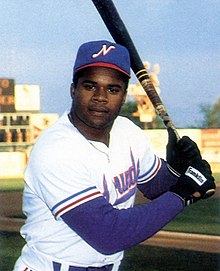This article has multiple issues. Please help improve it or discuss these issues on the talk page. (Learn how and when to remove these messages)
|

In baseball, a pinch hitter (PH) is a substitute batter. Batters can be substituted at any time while the ball is dead (not in active play); the manager may use any player who has not yet entered the game as a substitute. Unlike basketball, American football or ice hockey, and in a similar way to association football, baseball does not have a free substitution rule (at the professional level) and thus the replaced player is not allowed back into that game. The pinch hitter assumes the spot in the batting order of the player whom he replaces. Pinch hitters are commonly used to replace a weak hitter (often the pitcher) or to gain a platoon advantage.
The player chosen to be a pinch hitter is often a backup infielder or outfielder whose defensive skills are limited. In Major League Baseball (MLB), catchers are less likely to be called upon to pinch-hit, because most teams have only two catchers. Pitchers are rarely used as pinch hitters, because they tend to be worse hitters than other players on the team. However, some pitchers have been used as pinch hitters; this tactic had almost vanished by the 1980s, but later saw a comeback in situations when benches have diminished due to injuries, offering few other options beyond a team's 12 or 13 pitchers.
MLB, the Pacific League of Nippon Professional Baseball (NPB), the KBO League (in Korea), the Liga Mexicana de Béisbol (in México), and various other leagues use the designated hitter rule, such that pitchers seldom bat. This eliminates one possible situation in which a pinch hitter may be more desirable.
For statistical and scorekeeping purposes, the pinch hitter is denoted by "PH".[1]
- ^ McMahon, Rob, ed. (2009). USA Today Baseball Scorebook. Sterling Innovation. p. 11. ISBN 978-1-4027-6245-1.